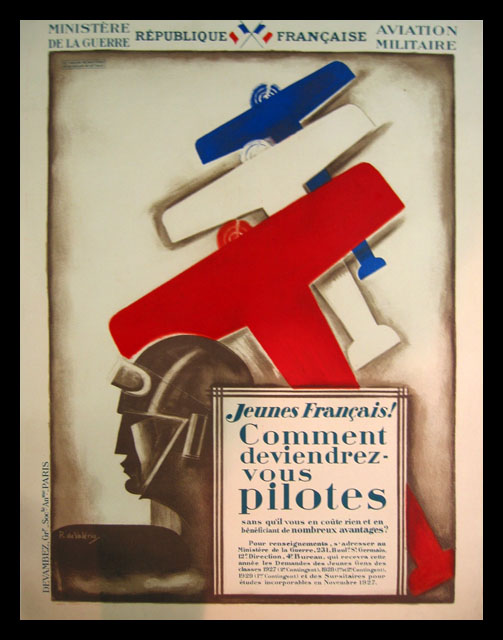 |
Title: Comment deviendrez-vous pilotes
Artist: Roger de Valerio
Year of Publication: 1927
Publisher: Devambez, Paris
Language: French
Size: 31 ½” x 23 ½ “
Index Number: 00284
Description:
This poster presents a visually striking recruiting effort by the French Ministry of War’s military aviation directorate. Before the creation of a completely independent air force, the l’Armée de l’Air, the French army controlled France’s military airpower, a situation very typical of Western Europe and the United States in the inter-war years.
The text calls out, “Young Frenchmen! Do you want to become pilots?” Numerous benefits are offered, with no cost to the potential flyers. The text goes on to add that applications are being taken for the recruiting classes of 1927, 1928, and 1929, with deferred conscripts prepared to join their regiments in November, 1927.
The French military had numerous challenges facing it in the decade of the twenties in terms of air power. |
After World War I ended, the ministries managing aviation began increasing the number of airplanes in service, which led to an increased need for mechanics and parts. Unfortunately, a lack of trained personnel and sufficient parts meant that many planes would be grounded on a regular basis. In 1926, the head of the Aeronautics directorate delivered the dire news that he doubted whether or not the air arm could even function effectively because the state of affairs was so bad.
These challenges extended to recruiting as well, hence the need for efforts such as this poster. The Ministry of War offered pilots training scholarships in return for military service, but the system had a significant flaw: the pilots were expected to maintain their training once in the reserves, which meant the system relied heavily on the pilot’s initiative to both finance himself and continue to train. The scholarship system alone was insufficient for recruiting a steadfast pool of pilots.
Also, the medical entrance exams were so tough that many potential recruits failed it, reducing the number of candidates who could go on for training. Furthermore, pilots did not have a clearly defined personnel status, which meant that licenses, privileges, and rights were not well delineated. It wasn’t until 1928 that the Ministry resolved this particular issue.
These recruiting difficulties extended to mechanics and officers. Mechanics had to sign on for several years of military service in exchange for training. Even though they were often responsible for training civilian mechanics, military mechanics were paid less than their civilian counterparts. This inequity was a significant frustration for the service personnel. For officers, a major recruiting difficulty was dispelling the public’s perception of flying as a “daredevil” pursuit that was extremely risky. In addition, there was little hope for rising through the ranks once recruited as so many experienced pilots, who had flown in World War I, already manned the higher-up posts. The French aviation officer corps thus increased at a slow pace, leading to larger numbers of older officers serving longer.
Noted French poster artist Roger de Valerio (1886—1951) created many posters during the interwar period for both military ventures and the newly created (1933) national airline, Air France. Born in Lille, he studied architecture at the Beaux-Arts academy in Paris. He worked in arts-related journalism and publishing as well as creating works, and in 1926 would become the artistic consultant for the poster’s publisher, Devambez. This publishing firm was revered in book and art printing and at the forefront of much of the new art being produced in Paris at the time.
One of the major art movements is represented by this poster: French Art Deco. Valerio was a noted practitioner of this style, which featured strong lines, geometric shapes, and repeating patterns—for example, the stylized airplanes in triplicate, the French national colors, and the heroic pilot profile in the lower left-hand corner. The text block, so different in style, seems like an afterthought. Possibly, this part of the poster was left blank so that, depending on the poster’s intended audience, different information could be provided.
Bibliography |
